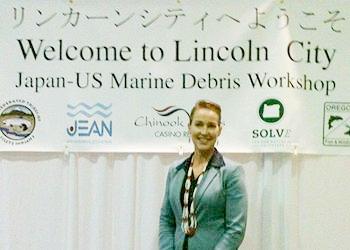
LINCOLN CITY, Oregon, February 18, 2013 (ENS) – Japanese environmentalists concerned about marine debris scattered across the Pacific by the March 2011 earthquake and tsunami came to Lincoln City on the weekend to coordinate with Oregon residents and help clean Oregon beaches.

As if to greet them, a barnacle-encrusted, battered fishing boat from Japan washed up on the Oregon shore five miles to the south just a few days before the Japanese delegation arrived. After Oregon Department of Fish and Wildlife scientists examined it for invasive species, the one-ton boat was hauled to a local landfill.
Tsunami debris began showing up on beaches in Hawaii and from Alaska to California last year. Two large docks have washed ashore, one last August in Oregon about 20 miles south of Lincoln City, and the other on Washington’s Olympic Peninsula last December. Many smaller pieces of debris from squid fishing lights to bits of plastic have made their way across the ocean.
The Japanese visitors and their Oregon counterparts held a beach cleanup Friday in the resort town of Lincoln City and a day-long Marine Debris Public Workshop Saturday that drew state and local officials and cleanup volunteers of all ages.
Oregon First Lady Cylvia Hayes welcomed the Japanese group and said their visit is important to her and to the people of Oregon.
“I was part of the movement that got the Governor’s Office to actually set up the Tsunami Debris Task Force,” she told ENS in an interview. “And then also I was in communication with SOLVE and Surfrider and some of those organizations early on to help make the most of this heightened opportunity to educate people about the issue in general.”
Hayes is founder and CEO of 3EStrategies, an environmental consulting firm. In the role of First Lady, she and “life partner” Governor John Kitzhaber have done several trade missions to Japan.
“I’ve been concerned about ocean issues for a long time,” Hayes said. “This tsunami debris issue brought together a couple of different concerns of mine. One is our relationship with our neighbors in Japan and, of course, the vast amounts of plastic trash that we have in our oceans in general.”

Hayes does beach cleanups, convenes and speaks to groups about tsunami debris and has filmed a public service announcement on the issue. “Honestly,” she said, “I don’t think my role is important now, because we have such an amazing network set up and really running it. The coastal communities are doing an amazing job, SOLVE and Surfrider are managing the cleanups with the Oregon Parks Department.”
“For me it will be keeping the issue alive with the public,” she said. “Those Japanese communities are still hammered and are still really struggling to put their lives back together. I was really moved by the comment today that they’re starting to be concerned that they’ll be forgotten two years after. Keeping awareness high is my focus now.”
Over the next year or two, an even greater wave of tsunami debris is expected to wash up on the Oregon coast.
Speaking at the workshop, Junichiro Noguchi, a technical official from Japan’s Ministry of the Environment, said about five million tons of debris entered the ocean after the tsunami. Some 3.5 million tons of that debris has settled into the sea bed near Japan, while the remaining 1.5 million tons is drifting in the ocean.
The Japan Environmental Action Network, a nongovernmental organization, coordinated the visit to Oregon. Through this visit, JEAN and the other participating Japanese organizations want to share information about their disaster recovery efforts with U.S. audiences and do research on the tsunami debris showing up on North American shores.
JEAN’s Azysa Jihuna said since 1990 the group has been working to solve the marine litter problem by providing information to the national government and Japanese society. To help solve the ocean’s garbage problem, we appeal to the public in the spring and fall to take part in coastal cleanup activities, Jihuna said.

Atsunori Nagayama, director of the Miyagi Disaster Relief Vounteer Center, told workshop participants he feels badly that Americans are cleaning up Japanese debris. “That’s why I came here from Miyagi,” he said. “I would like to come again to help clean up beaches here in Lincoln City.”
The Japanese were greeted warmly by Oregon residents. Lincoln City resident Bonnie VanBruggen said, “Our house is near the 45th parallel directly across from Japan. You’re our neighbors to the west across the ocean.”
Another resident told the group from Japan, “Thank you for coming, we love you.”
General Mike Caldwell, director of Oregon’s Office of Emergency Management, heads the Oregon Tsunami Debris Task Force, charged with incident preparedness and response, public safety, cleanup, and public outreach to address marine debris affecting Oregon’s coastline.
The task force includes representatives of State Police, Parks, Environmental Quality, Fish and Wildlife, Public Health, Transportation and the Marine Board, as well as local and tribal governments, state legislators, community organizations, and federal agencies.
The task force has partnered with 211info, a nonprofit phone hotline, to expand coverage for coastal communities to get information on and report issues related to marine debris. People can dial 2-1-1 and can also call 1-800-SAFE-NET (1-800-723-3638) to access resources and information.
“From the dock that washed ashore at Agate Beach, to increasing amounts of smaller debris showing up on Oregon’s coast, it is clear we will need to be ready to respond to a wide range of issues over the coming months and years,” said General Caldwell. “Our priority from the start has been to ensure we have a plan and the necessary resources in place to respond quickly and effectively to keep communities safe.”
Copyright Environment News Service (ENS) 2013. All rights reserved.
© 2013, Environment News Service. All rights reserved. Content may be quoted only with proper attribution and a direct link to the original article. Full reproduction is prohibited.
